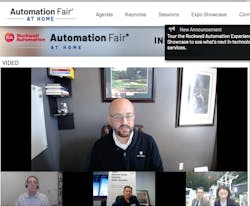From the way manufacturers work to who they hire, the need for remote access due to the pandemic has altered more than just how information is gathered. To that end, moving forward, manufacturers will put more emphasis on partnerships with machine builders and technology suppliers as a new set of issues arise that relate to the added automation now in place.
That was one message that came out of Rockwell Automation’s Automation Fair At Home—the company’s virtual version of its annual event featuring technical discussions, interactive labs, and segment-specific forums for automotive, chemical, food and beverage, life sciences, oil and gas, and more.
One track focused on OEMs, and one session titled “Ready or Not, the Remote OEM Future is Here,” caught my attention, as it took a closer look at how COVID-19 has been a catalyst for industry change across the board. Specifically, manufacturers have been forced into “digital acceleration,” which has required OEMs to pivot and adapt to new ways of selling, designing, commissioning, and servicing equipment.
The panel discussion featured speakers from Cama North America, a one-stop source for integrated robotic, cartoning, case packing, and sleeving machines; Sani-Matic Inc., a maker of sanitary process cleaning systems for the food and beverage and pharma industries; and Hirata Corp., an OEM and system integrator in the automotive, semiconductor, and home appliance sectors. And, while all three agree that customer needs are the same today as they were before the pandemic, the digital transformation has been fast-tracked because problems can’t be solved by putting more people on the job. Now, there’s more automation involved to solve a problem—which causes its own set of problems.
“If you have automation, how do you use it, how do you maintain it, and how will the OEM provide access,” said Bryan Downer, Sani-Matic’s vice president of sales and marketing. “Everything is changing drastically, and a lot of people are just trying to figure out how to do this.”
Similarly, machine builders are using new augmented reality and virtual reality (AR/VR) tools that require a new skillset. That means OEMs might need to hire people with expertise in these areas, but more likely it will require training. “This is where [partners] like Rockwell can provide that leadership,” Downer said. “If they can provide a platform and template for a centralized way of interaction for all of the different tools and software, I think that would be an opportunity for us as move into the future.”
Interestingly, the barriers to adoption that were prevalent in the past—namely cybersecurity concerns—have faded away under the current circumstances. “The initial barriers are starting to be perceived as gone, and now we can start moving forward in full force,” said Billy Goodman, managing director at Cama USA. “The pandemic has pushed us forward light-years in very short amount of time.”
It has also introduced new obstacles to overcome. “The playing field has change,” Goodman said, referring to servicing equipment. “It used to be we’d get someone out there in 24 hours, now there’s an immediate expectation of the OEM who has had to step up to ensure customers are running efficiently during the pandemic. Those expectations will carry over after the pandemic, which puts greater stress on us.”
Yet, that stress also gets OEMs thinking outside of the box to deliver new kinds of products and services. Downer said that the Sani-Matic recently mapped out the customer journey to identify different touchpoints and how it impacts virtual engagement through the machine’s lifecycle. “There is more we can do now as we have connectivity to the system, like providing OEE monitoring to help them understand where to optimize the system, or on-demand training with virtual tech support. I see a vast amount of opportunity for both the OEM and the customer once we embrace and understand what [the technology] can do for us.” That connectivity helped launch the company’s SaniTrend product, a cloud-based Software-as-a-Service (SaaS) that provides automated, secure data acquisition and reporting of critical cleaning cycle information for any automated cleaning system.
Cama’s Goodman said the digital twin, too, is an area of opportunity for OEMs. Using simulation to show how a machine will function helps with machine design, end user education, as well as overall risk assessment, using simulations to test speeds and cycles that ensure the machine is set up for long term success.
New OEM products and services, however, will require close partnerships—as much of the technology required to deliver all of this is outside of the OEM wheelhouse. “We will have to seek more innovative ways to make a better proposal for customers, and that happens in collaboration with Rockwell,” said Mika Ide, chief of sales engineering at Hirata Corp.
About the Author
Stephanie Neil
Editor-in-Chief, OEM Magazine

Leaders relevant to this article:
